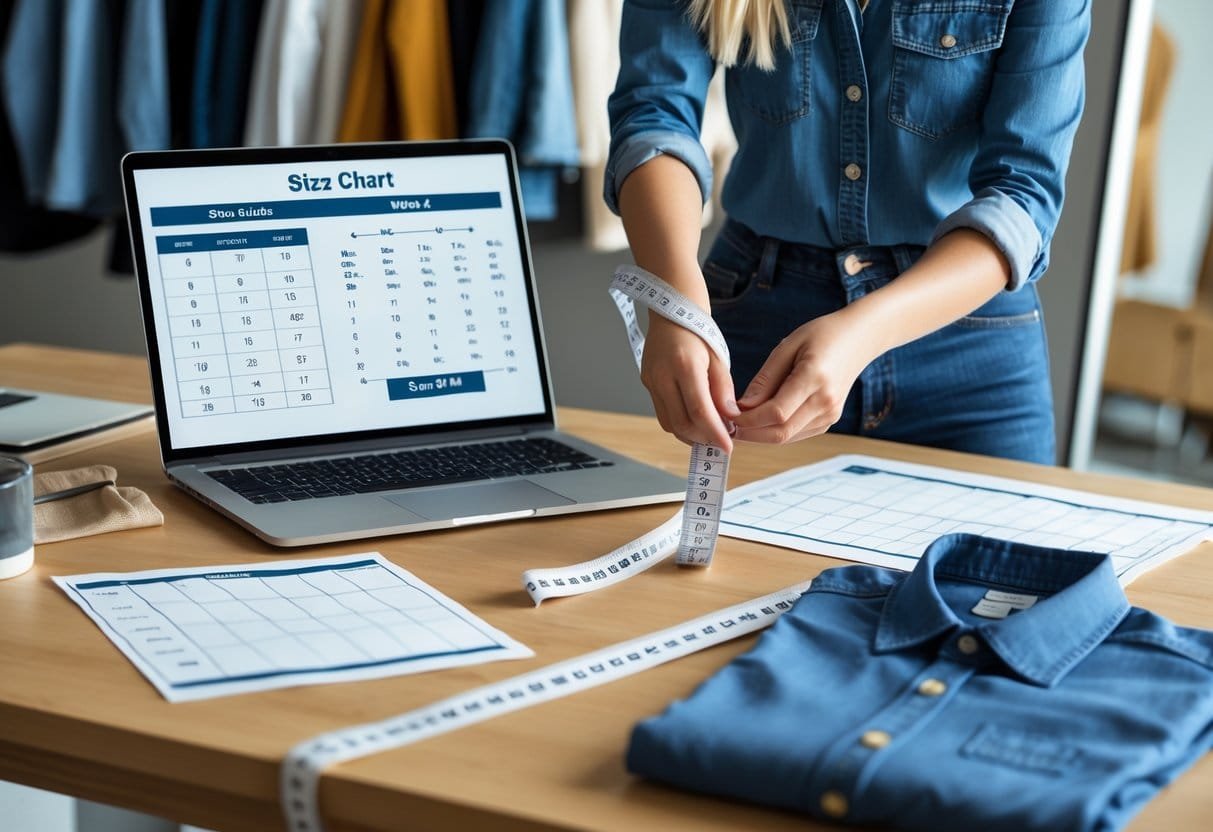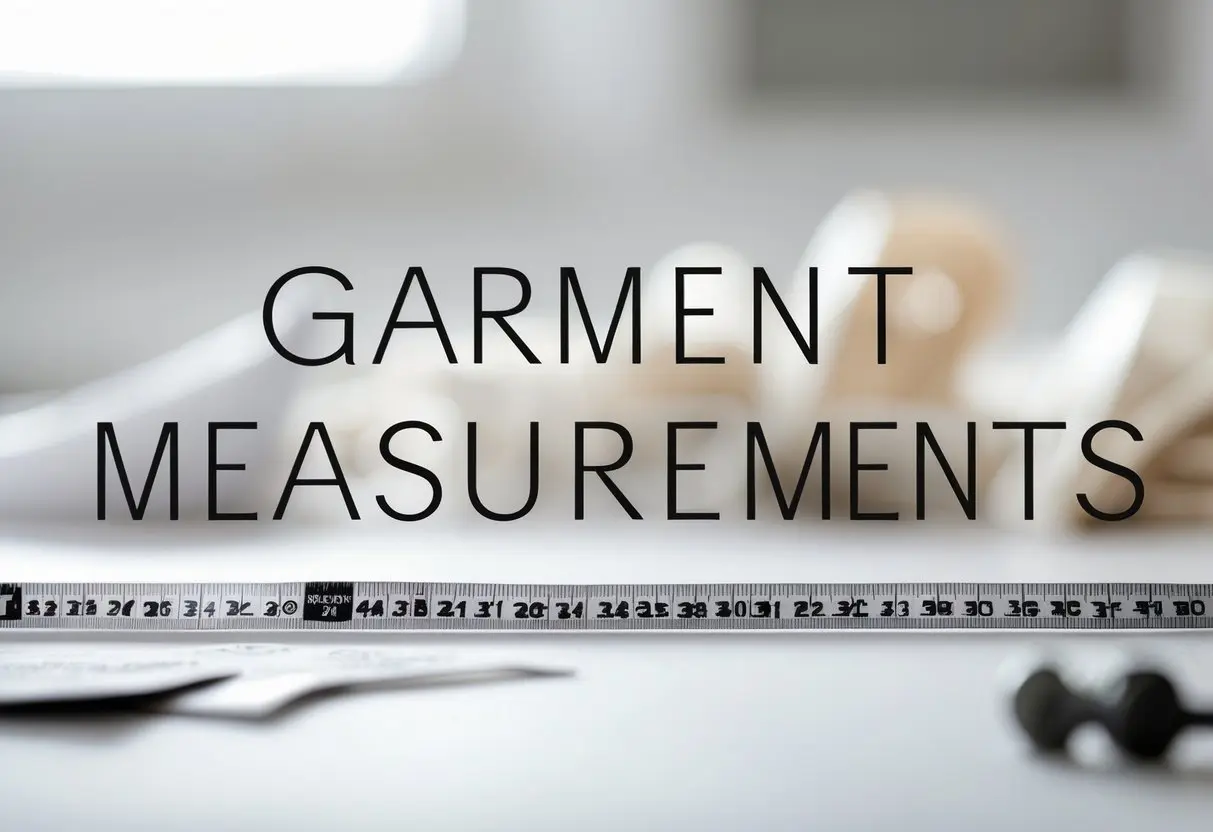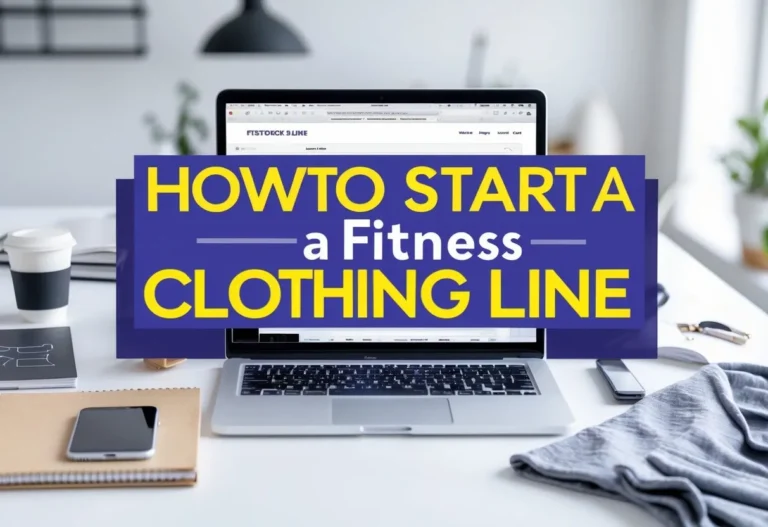How Important Are Body And Garment Measurements? A Complete Sizing Guide
Choosing the right clothing size depends on understanding both body and garment measurements. Body measurements show the actual size and shape of a person, while garment measurements reveal the size of the clothes, including extra room for comfort. Both measurements are important because they help ensure a better fit and more comfort when selecting clothing.

Many people get confused when they only look at one measurement type. For example, body measurements alone don’t account for ease or style preferences built into garment sizes. Knowing how these work together allows for more accurate sizing and helps avoid returns or ill-fitting clothes.
Table of Contents
Understanding how to read size charts and compare both types of measurements makes it easier to pick the right size no matter the brand or style. This knowledge is key for a smooth shopping experience and guarantees that the clothes will fit as expected.
Key Takeaways
- Both body and garment measurements influence how clothes fit.
- Garment sizes include extra room for comfort and style.
- Using size charts properly improves the chance of a good fit.
Why Both Body And Garment Measurements Matter

Knowing your body measurements alone is not enough to pick the right clothing size. It’s also important to understand garment measurements and how they relate to your body size. Both types of measurements work together to help find clothes that fit well and feel comfortable, especially when sizes vary across brands.
Accurate Fit And Comfort
Body measurements, like bust, waist, and hips, reflect a person’s actual size. Garment measurements, however, show the dimensions of the finished clothing item. These often include extra space called “ease” to allow for movement and comfort.
For example, if someone’s bust measures 38 inches, the garment might measure 41 or 42 inches across the bust. This added space prevents tightness and lets the wearer move freely. Without considering both measurements, clothes can feel too loose or too tight, affecting comfort.
Using both body and garment measurements helps ensure clothes fit the body shape well and provide the right balance of snugness and roominess.
Differences In Sizing Across Brands
Retail sizes can vary widely between competitors and brands. A size medium in one brand might be a size large in another. This makes relying on body measurements alone risky when buying clothes.
Garment measurements, usually found on size charts, offer more reliable data. They show the actual size of the clothing item including the ease added for style or function. Shoppers can compare these numbers with their body measurements to choose the best fit.
Understanding this helps avoid confusion and ensures shoppers pick sizes that best suit their unique body size information despite inconsistent retail sizes.
Role In Reducing Returns And Shopping Stress
Ill-fitting clothes often lead to returns and exchanges, increasing both time and stress for shoppers. Knowing both body and garment measurements before buying reduces guesswork and the chance of poor fit.
When shoppers compare their body measurements with garment measurements, they can better predict how the clothes will fit. This practice lowers the likelihood of needing to return items. It also saves money and effort.
In addition, accurate measurements reduce frustration, especially when shopping online and trying new or unfamiliar brands.
Impact On Confidence And Appearance
Clothes that fit well through the right balance of body and garment measurements enhance appearance. Properly fitted clothes highlight best features without tightness or excess fabric that hides the body’s shape.
When garments match the wearer’s body size and allow ease for natural movement, it boosts confidence. They feel more comfortable and look more polished.
Ignoring either set of measurements can result in outfits that feel awkward or uncomfortable, which can negatively affect self-esteem and how others perceive the wearer.
Understanding Body Measurements

Accurate body measurements are the foundation for selecting the right clothing size. Knowing which measurements matter and how to take them properly helps avoid common errors. Using the right tools and understanding proportion theories further improves fit and comfort.
Key Body Measurements To Know
The most useful body measurements for sizing include bust or chest, waist, hips, shoulder width, inseam, and sleeve length. These cover the main areas where clothing needs to fit well.
- Bust/Chest: Measures around the fullest part of the chest.
- Waist: Measured at the narrowest point, usually above the belly button.
- Hips: Taken around the fullest part of the hips.
- Shoulder Width: Measured from one shoulder edge to the other.
- Inseam: Length from the crotch to the bottom of the leg.
- Sleeve Length: From the shoulder seam to the wrist.
Each measurement plays a specific role in fit and comfort. For example, shoulder width affects how a shirt sits across the upper body, while inseam impacts pant length.
Tools For Taking Personal Measurements
A flexible tailor’s tape measure is the best tool for most body measurements. It bends easily around the body and gives precise readings. Some use a ruler or a measuring tape, but these can be too stiff or inaccurate on curves.
When measuring, wearing fitted clothing or undergarments improves accuracy. Having a friend help can reduce errors, especially for hard-to-reach places like back shoulder width.
Tips for Using Tools:
- Keep the tape level and snug, but not tight.
- Measure in front of a mirror or on a flat surface for evenness.
- Record measurements immediately to avoid forgetting.
Common Measuring Mistakes
Many people make measuring errors that lead to poor fit. One common mistake is pulling the tape too tight or leaving it too loose. This changes the real size and can make clothes too small or too large.
Another error is measuring over thick clothing. This adds extra inches that don’t reflect body size. Also, measuring only once can cause inconsistencies; it’s best to take each measurement two or three times and use the average.
Incorrect posture, like slouching, can distort measurements. Standing straight with relaxed shoulders gives the most accurate results.
Importance Of The Eight-Head Theory
The eight-head theory is a way to understand body proportions by dividing the body height into eight equal parts. Designers and tailors use this theory to help make clothes that match natural body shapes.
This theory explains where major landmarks like shoulders, waist, and hips should fall proportionally on the body. Knowing it helps in adjusting measurements and patterns for balanced clothing fit.
For example, if a person is shorter or taller than average, the eight-head method can guide the adjustments needed in sleeve length or inseam to maintain proper proportions. It provides a standard reference beyond raw numbers.
Understanding Garment Measurements

Garment measurements define the exact size of a clothing item and are essential for ensuring it fits as intended. These measurements include specific points on the garment that capture length, width, and shape. Fabric type and design details also impact how these measurements translate into fit.
Essential Garment Measurement Points
Garment measurement points, or points of measure (POM), are specific areas used to measure a garment. Common POM include:
- Bust/chest width: measured across the widest part of the chest.
- Waist width: measured at the narrowest part of the garment.
- Hip width: measured at the fullest hip area.
- Sleeve length: from shoulder seam to cuff.
- Garment length: from collar or waist to the hem.
These points help manufacturers and designers check if the garment meets size standards. Accurate POM ensure the garment will fit the body measurements of the target wearer while allowing for ease and styling.
Use Of Measurement Specs And Tech Packs
Measurement specs are detailed charts that list all garment measurements by size. These are part of a tech pack, which is a document sent to manufacturers.
The tech pack guides production by showing exactly how each size should measure at every POM. This helps with quality control throughout sampling and manufacturing. It simplifies checking whether garments meet design and fit targets before and after production. Consistent use of specs and tech packs reduces errors and supports communication between designers and factories.
Influence Of Fabric And Material On Fit
Fabric and material choice affect how garment measurements relate to actual fit. Stretchy or flexible fabrics can fit closer to body measurements despite smaller garment measurements. Stiffer fabrics may require added ease, making garment measurements larger than body dimensions.
The grain, weight, and drape of fabric also influence how a garment falls and feels on the wearer. Designers adjust garment measurement specs based on fabric type to maintain the intended fit and comfort. Understanding fabric properties is crucial when interpreting garment measurements and developing size charts.
How To Use Size Charts And Guides Effectively

Using size charts and guides correctly helps shoppers pick the right size and avoid mistakes. Knowing how to compare measurements, understand different chart types, and account for ease and design choices is key to making informed decisions.
Comparing Measurements To Size Charts
The first step is to take accurate body measurements like bust, waist, hips, and inseam. These should be compared directly to the size chart’s listed values. Size charts usually show body measurements that brands use to match garment sizes.
It helps to use a soft tape measure and stand relaxed. Measuring over undergarments or fitted clothes improves accuracy.
If a brand provides garment measurements too, shoppers can compare these to their body size for a better idea of fit. For example, a garment’s bust measurement will be larger than a body’s bust to allow for movement and comfort.
Decoding Standard VS Brand-Specific Charts
Standard size charts offer average body measurements for typical sizes across many brands. Designers and manufacturers use these to align their sizing with market expectations.
Brand-specific size guides, however, show measurements unique to a brand’s fits and designs. These often differ from standards, reflecting the brand’s target customer shape and style.
Shoppers need to check if the chart is standardized or brand-specific. For custom clothing manufacturers, using brand-specific guides ensures accurate sizing that matches the garment’s design.
Ease And Design Allowances In Sizing
Ease is the extra space added to body measurements in garment measurements to allow comfort and style.
For example, a tight-fit shirt might have little ease, while a loose jacket will have more. Designers decide on ease based on fabric type, garment purpose, and style.
Size charts that include both body and garment measurements let buyers see this difference clearly. Understanding ease helps customers choose a size that fits their preference for tight or relaxed clothing.
Using size guides with ease details also avoids confusion between body size and the actual product size.
Practical Measurement Techniques For Accurate Sizing

Getting accurate measurements requires attention to detail and using the right methods. Both the body and existing garments need precise measuring to ensure the best fit. It’s important to know how to handle common tools and alternatives when standard equipment isn’t available.
Measuring Your Body At Home
To measure the body accurately, a flexible tailor’s measuring tape is ideal. It should lie flat against the skin without squeezing. Key points to measure include the bust or chest at its fullest, the natural waist at the narrowest part, and the hips at the widest area. Measurements should be taken while standing straight and relaxed.
When measuring, the tape must stay parallel to the floor. Avoid pulling the tape too tight; leave enough space for comfort. Using a mirror or having a helper improves accuracy, especially for hard-to-reach areas like the back or shoulders. Wearing thin, fitted clothing or just an undergarment provides the best results.
Recording measurements immediately is important. A notepad or digital device helps track multiple measurements consistently, which is useful for tailoring or online shopping.
Measuring An Existing Garment
Measuring clothes that already fit well gives a clear reference for sizing. Use a flat surface to lay the garment smoothly before measuring. For shirts or tops, measure across the chest from armpit to armpit and from the shoulder seam to the hem.
For pants, measure the waist flat and doubled, as well as the inseam from crotch to hem. Sleeve length is important too, measured from the shoulder seam to the wrist. Always measure the garment without stretching it. Write down the measurements as they can differ from labeled sizes because every brand fits differently.
This technique helps match personal body measurements to actual garment dimensions, aiding accurate size selection. It’s especially useful when buying from a new brand or looking for custom fits.
Alternate Tools When Measuring Tape Is Unavailable
If a measuring tape is not available, flexible materials like string, rope, or even a phone charging cable can work. After wrapping the string around the body or garment, mark the overlap point. Then, lay the string flat beside a ruler or a known object to measure the length.
Using everyday objects such as an 8-inch piece of paper or a dollar bill can help measure increments when marking the string. Folding the paper into equal sections provides a simple way to estimate inches or centimeters.
This method requires patience and a steady hand to ensure the mark aligns correctly. It’s less precise than a tailor’s measuring tape but useful in a pinch. Accuracy improves if the person measuring checks the marks twice and measures without stretching the string.
Special Considerations In Clothing Fit

Choosing the right size depends on several detailed factors beyond just the basic measurements. Accurate fitting involves using models, expert adjustments, and understanding fabric behavior. These elements work together to ensure a garment fits well and feels comfortable.
Fit Sessions And Using A Fit Model
Fit sessions are critical for refining a garment’s size and shape. During these sessions, a fit model—someone whose body measurements represent the target customer—is dressed in prototypes. This process helps designers see how the clothing fits a real person.
The fit model’s measurements guide adjustments in the cutting room, ensuring the garment matches the intended fit and style. Precise measurements of the model’s bust, waist, and hips allow for targeted ease adjustments. Fit sessions identify issues like tightness or excess fabric before production.
Using a fit model helps set a consistent standard for all sizes in a brand. This reduces guesswork and leads to more reliable size charts. It also helps tailor garments to specific body shapes instead of relying solely on general measurements.
The Role Of The Tailor Or Dressmaker
Tailors and dressmakers are essential for achieving the perfect fit, especially for custom or altered clothing. They use their skills to adjust a garment based on precise body measurements and the wearer’s comfort.
These professionals understand how a garment should move and fit, factoring in the natural shape and posture of the body. They make changes to seams, darts, and hems to improve fit without sacrificing design.
The tailor also considers ease, which is the extra space in a garment that allows for movement and comfort. Knowing where to add or reduce ease is key to balancing style and wearability. A dressmaker’s expertise ensures the final product fits well in real life, beyond just numbers.
Fabric Flexibility And Ease Adjustments
Fabric type greatly affects how a garment fits. Stretch fabrics, like knits, require less ease because they can expand with the body. Woven fabrics, which don’t stretch, need more ease to allow comfortable movement.
Ease is the difference between body measurements and garment size. It accounts for breathing room, layering, and the garment’s intended style. For example, a tight-fitting shirt has little ease, while a loose jacket includes more.
Designers and the cutting room team adjust ease based on fabric behavior and garment use. Small differences in ease can change how a garment feels and looks. Proper ease ensures the piece fits the body without restricting movement or looking baggy.
Frequently Asked Questions
Choosing the right clothing size means understanding both body and garment measurements. This helps ensure comfort, proper fit, and efficient use of materials in garment making and buying.
How do you compare body measurements with garment measurements for an accurate fit?
Body measurements show the actual size of a person’s body. Garment measurements reveal the size of the clothing item, including extra space for comfort. Comparing the two helps determine if the garment will fit well with enough ease to move comfortably.
What should be the size difference between clothing and actual body measurements?
The difference is called “ease,” which allows room to breathe and move. This space depends on the garment type and fabric. For example, woven fabrics need more ease than stretchy knits. Typically, 1 to 4 inches of ease is added to body measurements.
Why are body measurements crucial for garment construction?
Accurate body measurements guide fabric cutting and pattern making. They help save fabric by avoiding guesswork and reduce the need for fit adjustments later. Tailors require these precise numbers to create clothes that fit the wearer correctly.
How can a sewing pattern size calculator assist in selecting the correct clothing size?
A pattern size calculator uses body measurements to recommend the best size to sew. It accounts for garment type and fabric ease. This tool lowers the risk of making garments that are too tight or loose.
What is the significance of the figure type in selecting the right pattern size?
Different body shapes affect how a garment fits. Understanding figure type helps choose patterns that suit a person’s unique proportions. This leads to better fit and reduces the need for alterations.
What do garment measurements indicate, and how are they used?
Garment measurements show the physical size of a finished clothing piece. They include dimensions like chest width, waist, hip, and sleeve length. Manufacturers and customers use these to check if the garment matches body measurements with added ease.







